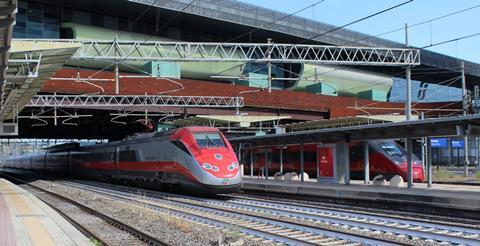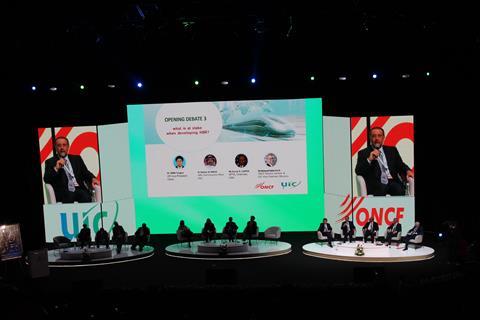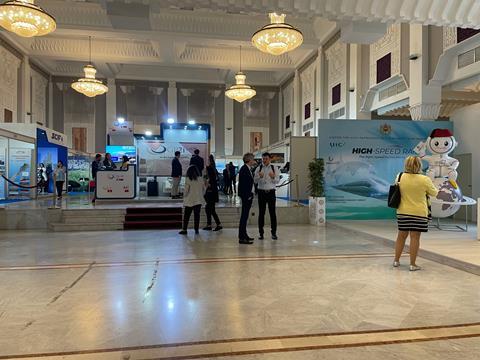With many railways seeing a rapid return in traffic post-Covid, the latest UIC World Congress on High Speed Rail in Marrakech on March 8-11 focused on questions of on-rail competition and co-operation with aviation. Benjámin Zelki reports from Morocco.

INTERNATIONAL: Since the International Union of Railways held the previous World Congress on High Speed Rail in 2018 in Ankara, much of the focus of the global passenger operating community has been on restoring ridership lost during the Covid-19 pandemic.
Delegates gathering in Marrakech reported that high speed rail traffic is getting back to near the volumes seen in 2019, and in some cases exceeding it. US national passenger operator Amtrak said its ridership had reached 95% of the pre-Covid level, even though it is at present only offering 85% of its previous capacity, while by early 2023, both Korean national operator Korail and open-access operator NTV-Italo had reported traffic figures exceeding 2019 levels.
Related to the effects of the pandemic, many operators said they were experiencing a drop in business travel as the ‘virtual presence’ in business is increasing. However, this does not necessarily mean a drop in overall traffic, but rather a change in the nature of this demand, explained Andrea Minuto Rizzo, Head of European & International Affairs at Italian national operator Trenitalia, at the opening of the congress. Rizzo added that Trenitalia was seeing an increase in leisure travel overall.

In terms of the expansion of high speed railways, UIC reported that 19 718 km of new lines are currently under construction. Should these all be successfully completed, the global high speed network will grow by a third from the current global total of 58 840 km.
Of the lines currently being built, 14 376 km are in the Asia-Pacific region — most of this in China — 3 062 km in Europe, 2 006 km in the Middle East, and 274 km in North America.
More intramodal competition
Competition within the rail market was a core topic among the speakers in Marrakech, reflecting a theme that had been addressed in depth in Ankara. But in 2018, realistic on-rail competition only existed in Italy between incumbent Trenitalia and Italo-NTV — South Korea also had a form of competition on its Seoul – Busan/Mokpo routes, but challenger Supreme Railways has incumbent Korail as a 41% shareholder.
In Ankara, the two Italian companies’ speakers shared a platform and agreed that competition had good for both of them. In Marrakech, there was a broader consensus among the speakers that competition leads to market growth, and a belief that it is in general beneficial for passengers.
The emerging competition in Spain between RENFE, Iryo and SNCF’s Ouigo business was the subject of much attention, amid news that ridership on the Madrid – València route, which has three-way competition, was now greater than that between Madrid and Sevilla, a journey offered only by RENFE. Talking to Railway Gazette, Diego Diaz, President of SNCF International, said the Spanish experience to date augured well for the nascent liberalisation of the high speed market in France.

Looking ahead, Prof Andrea Giuricin of University of Milano Bicocca predicted that more and more positive business cases would emerge based on head-to-head competition. ‘I believe, over the next 10 years, there will be some significant acquisitions and mergers’ in the European high speed market, he added.
However, capacity constraints remain a risk to this competitive dynamic, warned Dr Juan Montero, Professor at Spain’s Florence School Of Regulation. He cited looming issues at big city stations in Spain, although he explained that to date infrastructure manager ADIF has been able to meet the path requests of RENFE, Ouigo and Iryo. Nevertheless, he predicted that in the future infrastructure managers might have to make ‘painful decisions’ about urban nodes, for example by balancing demand for more slots on already busy corridors such as Madrid – Barcelona with the need to maintain sufficient service on a less intensive route, such as that serving the northwest of Spain.
A love-hate relationship
At the last congress, the question of whether high speed rail can replace aviation for medium-distance traffic, particularly in Europe, was a recurring theme. This year, speakers reported that little had generally changed over the past five years — no doubt in part because of the pandemic-related hiatus in travel in 2020-21.

However, speakers pointed to an emerging trend for cooperation with air as well as competition, as more rail links are being built to airports: Poland’s CPK has recently presented its plan to build up to 1 000 km of high speed lines in the country, and the main hub of this network would be a central airport built between Warszawa and Łódz. Elsewhere, trains are envisaged to run over planned links to three Italian airports not already served: Bergamo, Brindisi and Venezia; Naju Airport in South Korea is expected to be served by high speed rail in the future. Further examples include the connection for high speed services to reach Madrid’s Barajas Airport which is now being progressed, while the Rail Baltica network will also have a branch to Riga airport.
Referring to this trend as a ‘romance’ between aviation and rail, Jörg Ostwald, Head of Passenger Services & Product at Swiss Federal Railways, argued that it would be beneficial for rail to coordinate with air, because it can provide a reliable service to the airport, while also eliminating the pollution, congestion and extensive need for parking spaces that car use causes. He mentioned the rise of combined air+rail intermodal tickets as a good example of increasing cooperation between the two modes.
Ostwald felt that aviation companies would be part of the public transport market for the long term, not least for intercontinental travel, but he agreed that rail should take more role in medium-distance routes. ‘I looked if I could get here to Marrakech from Switzerland without flying, and it would have been a very long and complicated journey, and actually the smoother leg of the journey would have been the ferry from Spain and then the Al Boraq high speed train and conventional connection to Marrakech. The more complicated part would have been from Switzerland to the Spanish coast. It’s clear we still have a lot to do in Europe’, he insisted.

















